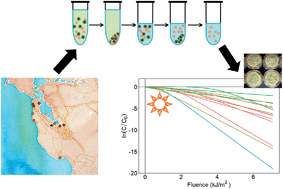Photoinactivation of uncultured, indigenous enterococci†
Abstract
Enterococci are used to monitor recreational water quality worldwide, so understanding their fate and transport in the environment is essential to the protection of human health. As such, researchers have documented enterococci inactivation under various exposure conditions and in diverse water matrices. However, the majority of studies have been performed using lab-cultured bacteria, which are distinct from indigenous, uncultured bacteria found in the environment. Here we investigate the photoinactivation of indigenous, uncultured enterococci from a range of sources, including wastewater treatment plants (WWTPs), marine beaches, urban streams, and a wastewater-influenced pond. We concentrated indigenous enterococci from their sources using filtration and centrifugation, placed them in a clear buffer solution, and then exposed them to simulated sunlight to measure their photoinactivation rates. First order decay rate constants (k) of indigenous, uncultured enterococci spanned an order of magnitude, from 0.3 to 2.3 m2 kJUVB−1. k values of indigenous enterococci from WWTPs tended to be larger than those from surface waters. The k value of lab-cultured Enterococcus faecalis was larger than those of indigenous, uncultured enterococci from most sources. Negative associations between the fraction of pigmented enterococci and sunlight susceptibility were observed. This work suggests that caution should be taken when extending results on bacterial photoinactivation obtained using lab-cultured bacteria to environmental bacteria, and that enterococci pigmentation may be a useful metric for estimating photoinactivation rate constants.



 Please wait while we load your content...
Please wait while we load your content...